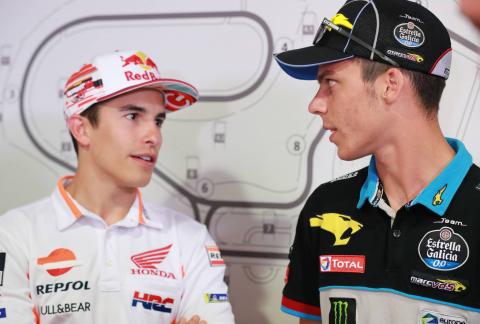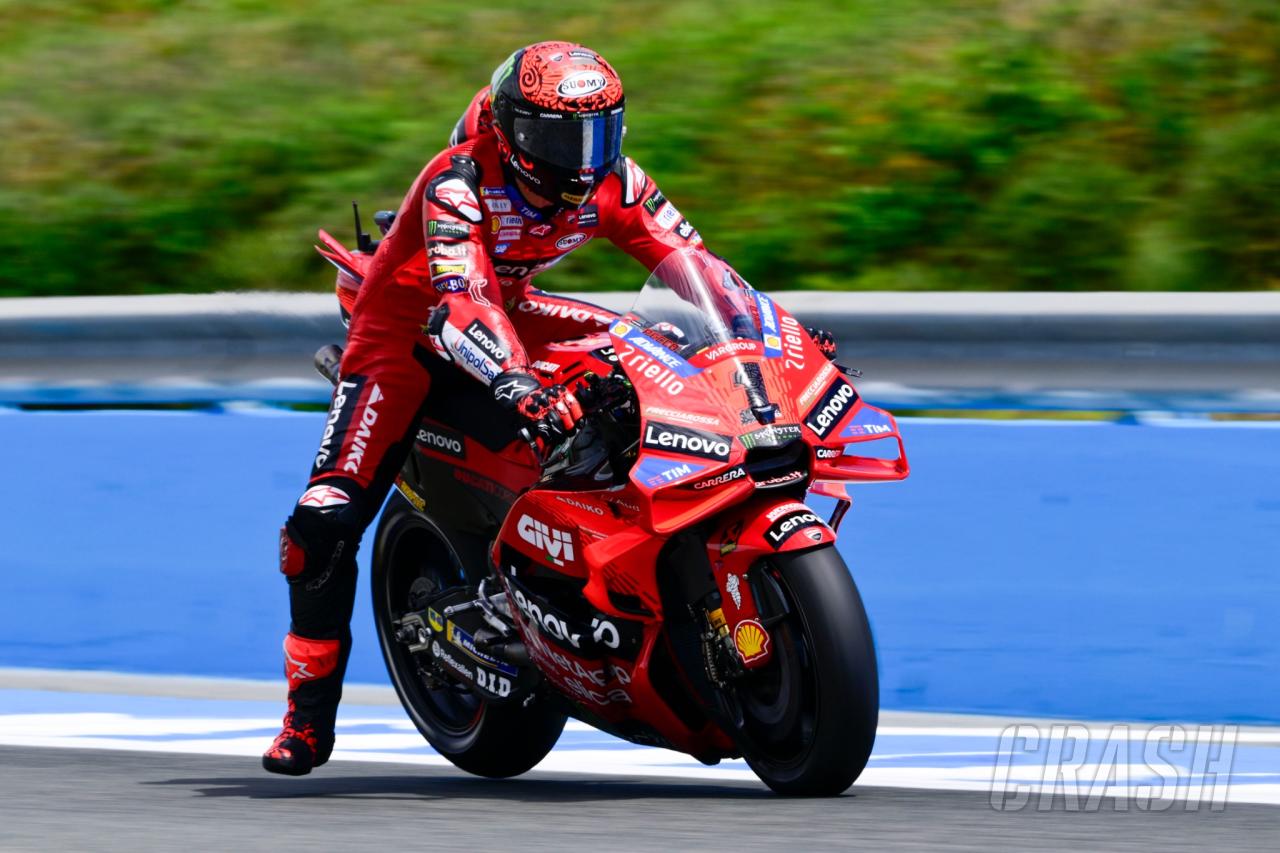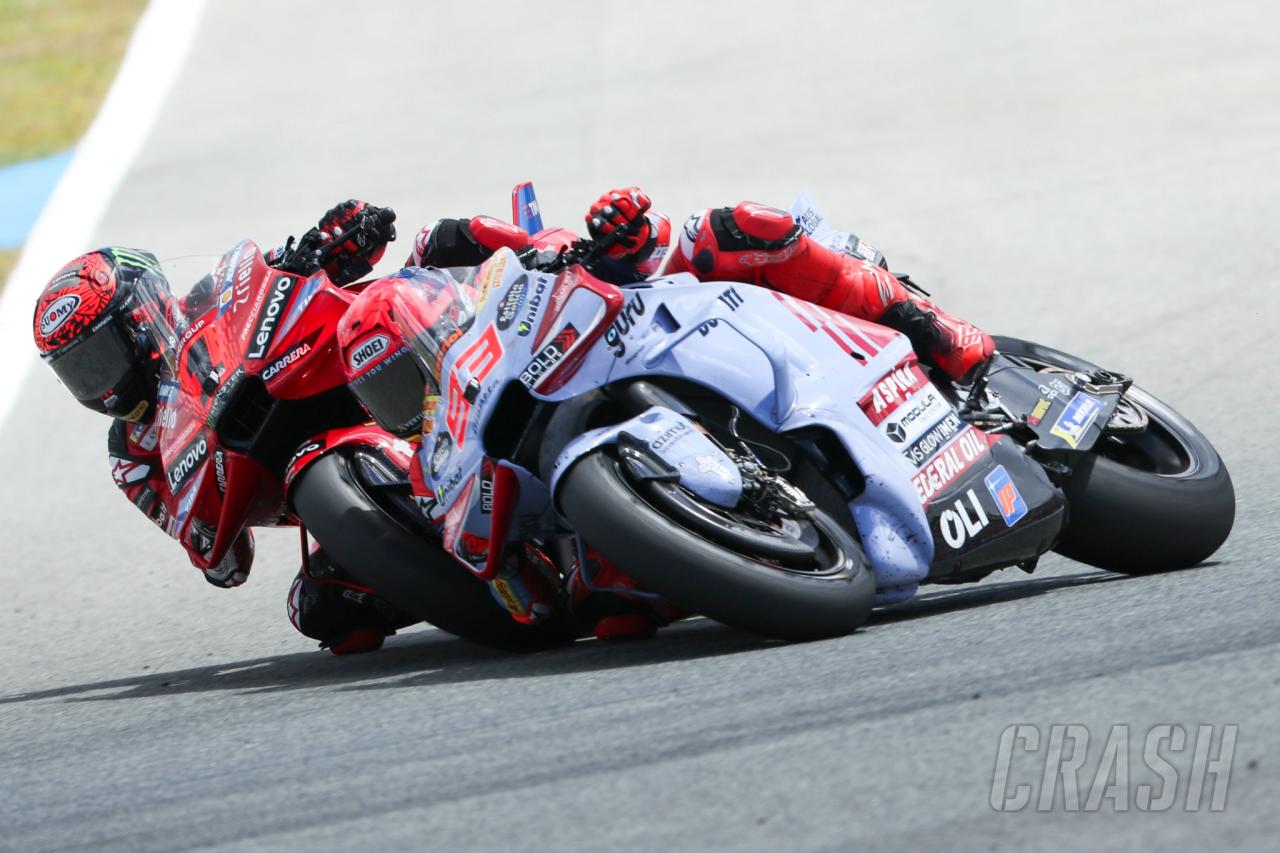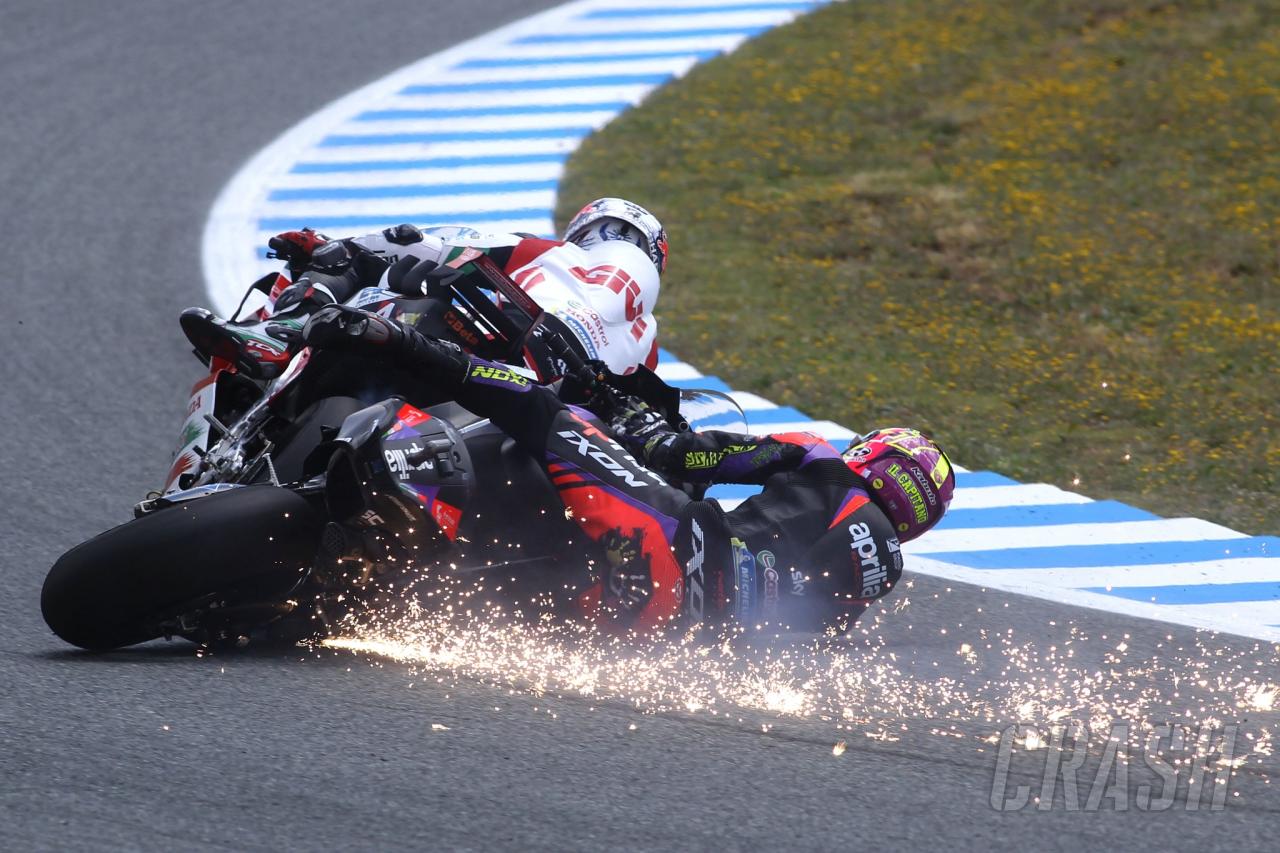
Joan Mir – ‘In two years he’ll fight with the best’
Watch Live Race and all sessions:
//www.trmotosports.com/motogp-izle/
Watch Replay Race and all sessions:
//www.trmotosports.com/category/tekrar-izle/
Not: Link seanslar başladıktan sonra aktif olacaktır.
MotoGP Race Calendar:
//www.trmotosports.com/-sezonu-motogp-yaris-takvimi/
Note: You can reach the race results and replays from Race Calendar.
MotoGP Standings:
//www.trmotosports.com/-sezonu-motogp-puan-durumu/
When the manager of an established MotoGP factory tells you a rider with less than two-and-a-half seasons’ worth of experience “deserves his own project,” your first thought may be mild disbelief. But Davide Brivio, Suzuki’s team boss, saw enough in Joan Mir’s performances over the past year to lead him to “feel he has something special.”
On the face of it, Suzuki’s signing of the 20-year old Majorcan represents a serious risk; he only made his debut in the intermediate class three months ago, and doesn’t appear to be in a position to challenge Francesco Bagnaia, Miguel Oliveira and the rest for the title this year.
Not even the fresh-faced Marc Marquez or Maverick Viñales were as inexperienced making the step up. Come next year’s curtain raiser in Qatar, Mir will have accumulated 56 grand prix starts. Viñales had 68 while Marquez had ten more.
Yet people that either have worked with Mir in the past or are currently deciphering his feedback in the garage feel the 20-year will take little time in getting up to speed when lining up alongside the best MotoGP has to offer.
Christian Lundberg first signed Mir for Leopard Racing after a promising season in the Red Bull Rookies Cup in 2014, during which he contested the title with current Moto3 championship leader Jorge Martin. From there, the talented Spaniard would compete in the 2015 FIM Junior World Championship series with the likes of Aron Canet and Nicolo Bulega.
“We had an bike with a stock engine,” says Lundberg. “It was very difficult to beat Canet and Bulega in this championship. Anyway, he won four or five races [but] we didn’t have money, we didn’t have anything to win this title. It was really a miracle that the bike stayed until the end of the race.”
Meanwhile Pete Benson is the Majorcan’s crew chief in the Marc VDS Moto2 squad. Under his guidance, Mir was showing race winning pace in the third race at the Circuit of the Americas and he made his first podium appearance two outings later in France. spoke to both men to understand
Natural ability
No rider casts a spell of dominance over their rivals, as Mir did in Moto3 a year ago, without having something a little special concealed within. The Majorcan came away from 2017 with ten race wins, one shy of Rossi’s all-time record for the junior class.
But Lundberg sees a difference between Rossi’s feats and those of his former rider. “No rider wins ten races in Moto3. It’s very difficult. It’s crazy difficult. OK, Valentino won eleven, but in Valentino’s age he had an official Aprilia bike. Not many others had the same.
“Now all the bikes are the same. Maybe one team can work better than another. But the difference is very small. Before there was a lot of difference between a factory rider and another with a two-year old bike. For Valentino it was easier to win eleven races. But in Moto3, no one had done it before.”
“You could see he had the ability to sit there and pace the races perfectly,” says Benson, who took a special interest in Mir’s performances from early in 2017 when it became clear he was a target for Marc VDS. “You didn’t see him take off and lead a race very often from start to finish; he’d sit there running fifth or sixth and then in the last five or six laps he’d smoke everybody. It was quite clear he had a good mental attitude and ability to think the race out as it was coming along. That’s something not many people have.”
And his adaption to Moto2 didn’t take long. Benson says, “There is no one thing [that stands out in his riding]. He generally just does everything really well. He adapted very quickly to having to pick the bike up. Moto3, you stay on the side of the tyre and use a lot of corner speed, whereas Moto2 is more like MotoGP, where you stop, turn, pick the bike up.
“The Moto2 tyres don’t have a lot of grip on the edge of the tyres so you have to get them off the edge of the tyre. It’s something he adapted to really quickly. That’s something that people generally struggle with when they come from Moto3 to Moto2. He didn’t. He got onto it really quickly.”
Conviction
This was something Brivio noted when negotiating with Mir earlier this year. “Talking to him you can see the way he answers, the way he talks, he has a very clear mind. He knows what he wants. He’s really motivated. He’s very committed.”
It’s been apparent in his approach too. At Assen a year ago, Mir found himself in the midst of a typically frenetic nine-rider Moto3 fight for the win. With eight corners still to navigate, he was well placed to add to earlier triumphs in Qatar, Argentina, France and Barcelona. Entering turn ten, he was plotting. Of course he was. But here, Mir was plotting too much. “I was too confident,” he later told me. “I said, ‘OK, I have won this race, easily’ and it wasn’t [the case].”
Attempting to allow two riders past so he could re-pass them at the final chicane, he went wide, had to sit up and dropped to ninth. His team’s press release for the following weekend’s round at Sachsenring showed he was not keen to repeat the mistake. “There will not be a second time,” he was quoted as saying. He would not be defeated until late August.
A fine example of his self-belief came at the close of 2016. Mir and Leopard had just completed a solid rookie campaign in Moto3 aboard KTM machinery. He had won a race, taken two further podiums and attracted the admiration of Tom Jojic, then the factory’s overseer of its junior class activities. But he wanted a change. “He made one race with the Honda in Phillip Island in 2015 because Hiroki Ono wasn’t there,” says Lundberg. “He was fighting for the race win. He immediately loved the bike.
“He never had a good feeling with KTM from the beginning. He won one race in Austria, and he was fast. At the end of the season honestly we were fast with the KTM. Every race he was fighting at the front, and in the last race he was second. At Misano starting from 26th he made third position also.
“But he was loving Honda since 2015 so he asked us to change to Honda. If not, he would have left the team. We made a big effort. We had to buy everything new again. But in the end we were world champions so this was the important thing for us.” And Lundberg was sure to make a considerable investment and follow its rider’s desire? “Absolutely,” he says. “I was convinced from the first time I saw him on one of my bikes. Immediately! Immediately!”
Lundberg found that through 2017 too: “He was sure last season he was faster than everybody. Also he wasn’t afraid of the races. Maybe he started 16th on the grid but he would tell me, ‘Don’t worry. The bike is OK so tomorrow I will do a good race.’ He was really, really confident in himself. In the end, he didn’t really move the bike at all. He was looking at all the partial times on every lap, seeing where he could gain time. Only if there was a very big problem, he wanted to change the bike. He understood the circuit, the bike. It’s much easier to work like this.”
Work ethic
For a rider that has only recently entered his twenties, Mir takes physical preparation very seriously. He spends a lot of time on bikes away from the track, whether it be on supermotards or motocross machines. And with trainer Tomas Comás, with whom he has worked during his entire time in the world championship, by his side, Mir has incorporated yoga into a relentless training regime to increase flexibility – one of the key reasons behind Marc Marquez’s near bionic ability to avoid injury.
“He has a really good training programme,” says Lundberg. “When he’s training on the bike in Palma, he tries the same that Marquez does in MotoGP now. On Friday or Saturday maybe he es five times to find the limit but it’s difficult to see him on the floor on Sunday. When Joan’s training he’s always trying to save the front closing, to save the high-side. He’s pushing on the limit his bikes – supermotos, motocross, every bike. This helps.
“Also, he’s going to train with real focus. He’s not having fun. He’s training. Not many riders do this. They are going to have fun and to play with the bikes, but it is not training. Honestly, he really trains.
“He has a great control of the bike. Every time he had a high-side last year, he saved it. [Enea] Bastianini [Leopard Racing’s current Moto3 rider] now three high-sides and three times he was on the floor. He feels the limit much more than every other rider that I had before. The same as Marquez does in MotoGP. Not so many riders are doing this. His way of training is with this goal; to manage really complicated situations on the bike. This helps for sure in Moto2.”
This also helps in those last lap fights. Lundberg again: “This for sure it’s his brain. He can switch the brain and also ride. Not so many can ride on the limit with the brain switched on. He’s able to do this. It’s like multi-tasking. For other riders, when they’re on the limit, they can do nothing else. He was really focussed on the last laps.”
Behaviour
Off the bike, Mir comes across as softly spoken and polite. “He’s one of the most normal people,” says Benson. “He’s like Frankie [Franco Morbidelli, Benson’s rider in 2015 & ‘16] – very easy to get along with. He has a broad knowledge of life and also a good balance in life. As much as he wants to win races, he also has another side to him, where he has good fun and enjoys himself. He’s just an everyday kind of guy with a special talent.”
Temper tantrums are commonplace in grand prix racing. But Lundberg often found a calm head in his garage, even if things weren’t going well. “Sometimes he said, ‘The bike isn’t 100 percent, but leave it like this because I know it very well what it’s doing and for the race I can manage it.’ OK, maybe we had the solution but he didn’t want to change the bike because he knows the bike’s reactions in every moment,” says Lundberg. “It was safer for him to ride this bike than a different one in the race.”
How will he do in 2019?
So how will he get on in MotoGP? Benson is in little doubt: “He’ll adapt. He’s adaptable. He’ll figure it out. If he’s working with some people that will give him good guidance, he’ll figure it out pretty quickly. He’s got good people with him. He’s got a couple of guys that work with him all the time and they’re really, really sharp. He’ll get it figured out pretty quick.
“I think if he keeps improving the way he has been, he probably won’t have a lot to learn by the end of this year,” he says before adding with a smile: “He’ll probably get bored anyway so it’s a good opportunity.”
Lundberg agrees: “MotoGP is difficult and different. He must understand so many things like electronics. But I’m sure he will be there fighting very, very soon. Very soon. We will see. I trust that in two years he will be fighting with the best riders in MotoGP.”
For motorsport news follow TRmotosports on social media.
Facebook: https://www.facebook.com/TRmotosports
Twitter: https://twitter.com/TRmotosports
Instagram: https://instagram.com/trmotosports/
Linkedin: https://www.linkedin.com/company/trmotosports-com


